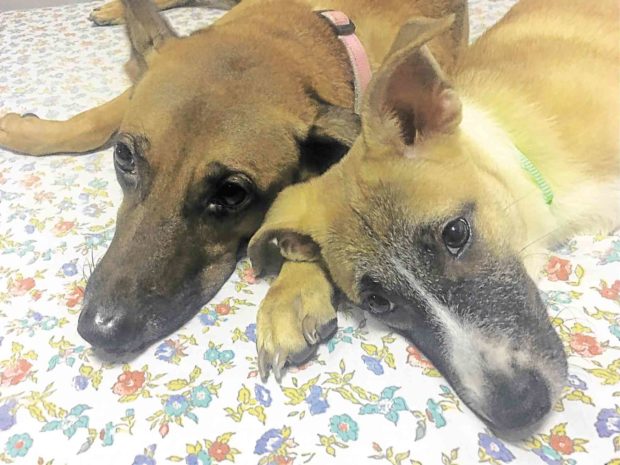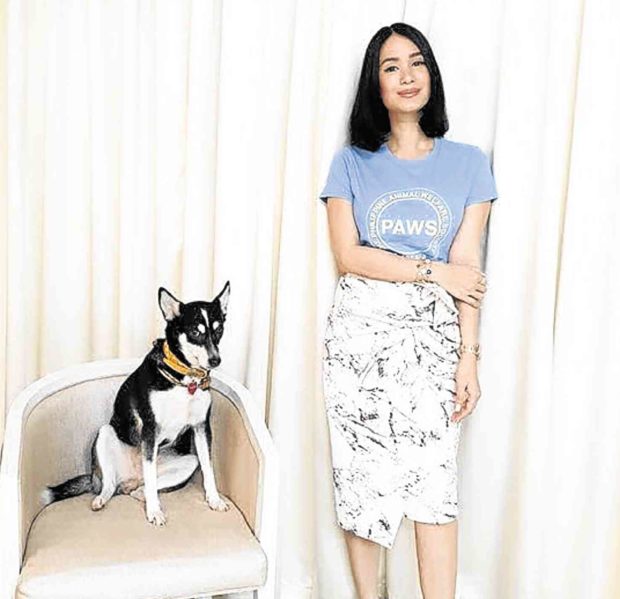
To be clear, I have nothing against purebred dogs. My heart dog—my canine soulmate—was a yellow Labrador named Banana, who was with me for seven years.
While Banana was alive, on Mother’s Day 2009, and probably knowing she wouldn’t be around for long, she literally led me to a mangy, scabies-infested puppy with a skinny neck and a bloated belly (full of worms, I would later learn) who seemed ready to die on our doorstep.
In a supreme display of spunk, the puppy looked up at the huge yellow dog, pulled herself up to her full, puny height, and barked. She was going to defend herself, if it was the last thing she did. I was floored by her spirit.
That puppy was Kikay (named after St. Francis of Assisi), my very first “asPin” (asong Pinoy, aka the more politically incorrect askal or asong kalye). I adopted an asPin not by choice, but because I didn’t have the heart to leave her to die.
She gave me scabies, for which I had to get treated by a dermatologist. She made a lot of noise, and took a while to housebreak.
She had infuriating habits which, some snooty friends suggested, purebred dogs didn’t have, like rolling around in cat poo (the friends were wrong— but try cleaning that up) and trying to swallow anything she could get her teeth on.
There is also the perception, which remains to this day, that asPins are lesser dogs; they have weak personalities, they bite and they’re dirty. I didn’t grasp the absurdity and extent of this until I got Kikay. People would ask when I was getting another dog after Banana’s death, and I would say, “I have Kikay.” “Yes, but when are you getting a real dog?” I had to confirm if Kikay had a Made in China label somewhere; last I checked, she ate and pooped.
I’d walk her and bring her places, and people would ask enthusiastically, “Anong breed siya?” “AsPin,” I’d say, and the tone would become almost apologetic or disappointed. “Ah, asPin lang.” Lang.
‘May lahi’
Once I engaged a commenter.
“Bakit, pangit ba ang asPin?”
“Siempre, mas maganda may lahi.” (Siempre?!!)
“So mas pangit ’yung Pinoy kaysa ibang lahi, feeling mo?”
I’d invariably get a glare, a puzzled look, or a simple walk-out.
Some try to humor me.
“Naku, hindi lang ’yan asPin, may lahi yan.”
“Hindi, asPin siya, 100 percent.”
“Eh bakit maganda? Mukhang nalahian. Hindi ba Belgian? O German shepherd?”
“HINDI. AsPin ’yan.”
And they’d still be mumbling as they walked away: “Siguradong nalahian yan.”
The latter, I should really consider a compliment. Because with love, good food (lots of raw food, fruit and vegetables) and regular care, Kikay has become a big, beautiful dog. Her build and silhouette are classic asPin, though, features you see in street dogs in most Asian countries—the pointed ears that stay alert, the long tail to swat at flies, perhaps, and the narrow paws to help them navigate hot roads. These dogs weren’t designed to laze around in beds in air-conditioned rooms—but they certainly deserve to, and learn to do so pretty quickly. (See picture above of my shameless babies.)
I once read that distrust may have become ingrained in the DNA of asPins, after years of being maltreated and slaughtered for pulutan by drunks. I saw it in Kikay, who would tense up every time I hugged her during her first year at home. It was a victory for me when I smothered her once, and for the first time ever, she closed her eyes and sighed to take in all the love.
“I notice they are affectionate with family, but only after trust has been established,” said my friend Dr. Marga de la Rosa Carpio of Vets in Practice. “Otherwise, they are reluctant, reserved and cautious. They have to be socialized early in life. They are independent, not needy, and like to play on their own terms. They are also naturally clean (did you read that, snobs?!!) and require minimal grooming.”
I saw the same hesitation in Kikay’s little brother Kiko (yes, also named after the saint), whom my friend, über animal savior Nice Rodriguez, rescued, along with his four siblings, from under a car in 2016. Like most rescues, they were a filthy, mangy bunch. “Save one boy for me,” I asked Nice, and two months later, she brought me an adorable, beautiful puppy.

Wary
Kiko looks more like a mutt, with floppy ears and patches of white (definitely nalahian?), making him as cute and goofy as his Ate Kikay is poised and elegant. Yet he was initially so wary, he actually tried to bite me once when I attempted to leash him—which, I have to admit, hurt my feelings.
Another friend, dog trainer Brad Feliciano, advised, “Dedma lang. No emotion.” And it worked. I whistled and hummed as he growled away, and he never tried to bite me again.
The love worked, too; now Kiko sleeps right beside me, lying between my pillow and the wall, his face inches from mine, snoring away.
Kiko has yet to be “tested,” as it were, but Kikay passed hers with flying colors. The year I was diagnosed with cancer, I had to stand my ground when my doctors insisted my dog stay outside my room. So we compromised by fastidiously cleaning Kikay’s paws and private parts after every walk, and spraying her with organic disinfectant. (It’s a habit that has stayed with us to this day, since both dogs sleep with me.)
Kikay was my sentinel, watching intently as I staggered to the bathroom after chemotherapy; she would often walk in when I sat on the toilet, just to keep me company. She was quiet, gentle, and on her own, opted to sleep near my feet, as if she knew well not to get too close to my face.
I was reminded again that you get the dog you need at different points in your life; Kikay was low-maintenance and had no health issues for the entire year I was under treatment.
Appreciation
Today, I have become such a fan of asPins, I don’t think I’ll ever acquire another pure-bred dog again in my life, simply because many of these literal underdogs need a home. Appreciation has grown in the last few years—PAWS has a strong campaign to “have a heart for asPins,” led by asPin champion Heart Evangelista herself—but they’re still being abused, beaten, euthanized, in large part because people still don’t spay and neuter their pets, and too many stray dogs mean more trouble for asPins.
I try to do my part by taking the best care of my two babies. I now have a 10-year-old senior girl with white hair and the beginnings of cataracts, and a three-year-old adolescent boy with boundless energy.
My idea of happiness is lying in bed, with my little boy beside my pillow and my baby girl draped over my leg.
They’re lucky to have me, friends say. I think it’s the other way around.













































